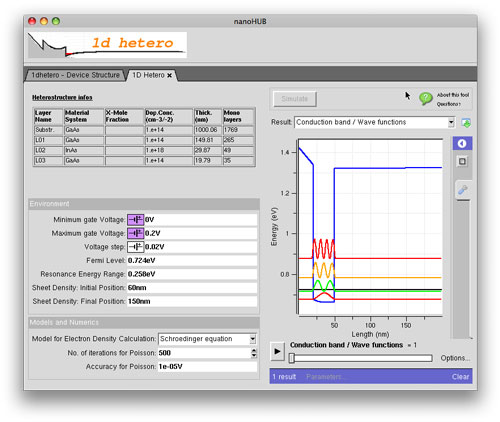| Posted: June 14, 2009 |
New version of free quantum effect simulator released |
|
(Nanowerk News) A new version of 1dhetero, a simulator able to cope all relevant quantum effects in a heterostructures at atomistic level, has been released at nanoHUB.org.
|
 |
| Simulation of quantum wave function in a GaAs/InAs/GaAs heterostructure
|
|
The tool is being developed at Purdue University in Prof. G. Klimeck's group, who has a strong background in quantum simulations, especially in quantum transport. Dr. J.M. Sellier is the main developer and maintainer of the tool in his group. He is very enthusiastic about 1dhetero and says:
|
|
"This tool is going to be the main reference in the experimentalist community. Many advanced theoretical and numerical methods are being developed here at Purdue and those tools are going to be released as the engine of 1dhetero very soon. The main engine of 1dhetero is called OMEN3D which has been developed at Purdue and represents probably the most advanced quantum simulator in the world. All versions are deployed in nanoHUB for free and everybody can use it."
|
|
The 1D Heterostructure Tool is a program for the design and simulation of 1D heterostructures. It currently implements the effective mass bandstructure model and parameters for materials belonging to GaAs substrate such as GaP, InAs, AlGaAs etc.. The user can also choose to use the semiclassical Fermi-Dirac distribution which can be faster on bigger devices. A friendly GUI has been implemented in order to easily design the heterostructure to be simulated. It is possible to define a new device in a few mouse clicks. The layers can be easily duplicated by means of "copy and paste" features and the heterostructure energy band can be visualized before the simulation is launched.
|
|
|
|
1dhetero comes with a Resonance Finder able to cope all eigen energies in a user specified interval around the Fermi level. It also gives many informations about the heterostructure, like electron density, conduction band edges, wave functions, eigen energies, sheet densities, etc.
|
|
This tool is already very promising and in the next versions will have many other features like strain calculations, more advanced electronic structure models, etc. An interactive Resonance Finder is also under development at the present time.
|

